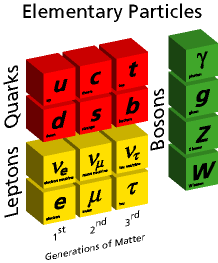 |
Run II Discovery |

|
The Standard Model
What is Fermilab? - Run II Newscasts - Analyze the Data - Particle Physics Bibliography
- leptons, small point-like particles like the electron, the muon and the ghostly neutrino
- quarks, which combine to form hadrons, particles as familiar as the proton and as exotic as the omega-minus
- bosons, the particles that carry forces between other particles

| Leptons and quarks are arranged by the generation in which they were discovered. Thus, as you see in the diagram, the Generation I of leptons is the electron paired with the electron neutrino; Generation I of quarks is made up of the up and the down quarks. These generations more or less correspond with the energies needed to uncover them. Thus the Generation II charm and strange quarks are more massive, less stable, and require more energy to produce than the up or down.
The same can be said of the Generation II charged lepton, the muon. Note that the bosons are not arranged this way. Rather, they occupy a single separate column. Also, each particle that carries electrical charge has an antiparticle of opposite charge: the electron e- has the positron e+ and the down quark (charge -1/3) has the antidown (charge +1/3); even the W boson comes in W+ and W- varieties. |